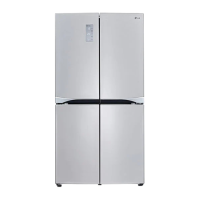36
TROUBLESHOOTING
ENGLISH
Problem Possible Causes Solutions
Frost or ice
crystals form
on frozen food
(outside of
package).
Door is opened frequently or
for long periods of time.
When the doors are opened often or for
long periods of time, warm, humid air
enters the compartment. This raises the
temperature and moisture level within the
compartment. Increased moisture will lead
to frost and condensation. To lessen the
effect, reduce the frequency and duration of
door openings.
Door is not closing properly. Refer to the Doors will not close correctly
or pop open section in the Troubleshooting
section.
Refrigerator or
Freezer section
is too cold.
Incorrect temperature
control settings.
If the temperature is too cold, adjust the
control one increment at a time and wait
for the temperature to stabilize. Refer to
the Setting the Controls section for more
information.
Frost or
ice crystals
on frozen
food (inside
of sealed
package).
Condensation from food
with a high water content
has frozen inside of the food
package.
This is normal for food items with a high
water content.
Food has been left in the
freezer for a long period of
time.
Do not store food items with high water
content in the freezer for a long period of
time.
Clicking The defrost control will click
when the automatic defrost
cycle begins and ends.
The thermostat control (or
refrigerator control on some
models) will also click when
cycling on and off.
Normal Operation
Rattling Rattling noises may come
from the flow of refrigerant,
the water line on the back
of the unit, or items stored
on top of or around the
refrigerator.
Normal Operation
Refrigerator is not resting
solidly on the floor.
Floor is weak or uneven or leveling
legs need to be adjusted. See the Door
Alignment section.
Refrigerator with linear
compressor was jarred while
running.
Normal Operation

